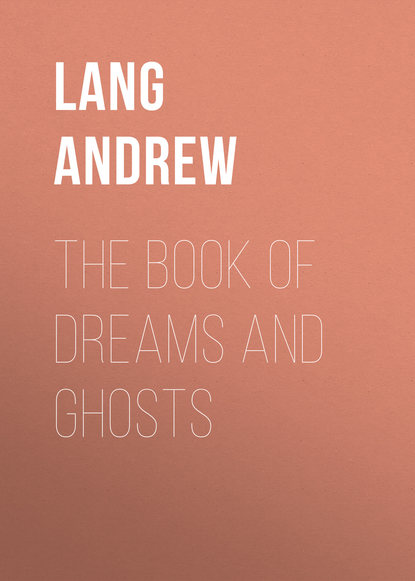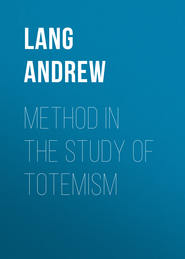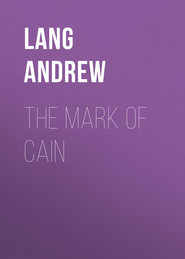По всем вопросам обращайтесь на: info@litportal.ru
(©) 2003-2024.
✖
The Book of Dreams and Ghosts
Настройки чтения
Размер шрифта
Высота строк
Поля
One very curious circumstance in connection with the assassination of Mr. Perceval has never been noticed. A rumour or report of the deed reached Bude Kirk, a village near Annan, on the night of Sunday, May 10, a day before the crime was committed! This was stated in the Dumfries and Galloway Courier, and copied in The Times of May 25. On May 28, the Perth Courier quotes the Dumfries paper, and adds that “the Rev. Mr. Yorstoun, minister of Hoddam (ob. 1833), has visited Bude Kirk and has obtained the most satisfactory proof of the rumour having existed” on May 10, but the rumour cannot be traced to its source. Mr. Yorstoun authorises the mention of his name. TheTimes of June 2 says that “the report is without foundation”. If Williams talked everywhere of his dream, on May 3, some garbled shape of it may conceivably have floated to Bude Kirk by May 10, and originated the rumour. Whoever started it would keep quiet when the real news arrived for fear of being implicated in a conspiracy as accessory before the fact. No trace of Mr. Williams’s dream occurs in the contemporary London papers.
The best version of the dream to follow is probably that signed by Mr. Williams himself in 1832. [20 - S.P.R., v., 324.]
It may, of course, be argued by people who accept Mr. Williams’s dream as a revelation of the future that it reached his mind from the purpose conceived in Bellingham’s mind, by way of “mental telegraphy”. [21 - Ibid., 324.]
DREAM OF MR. PERCEVAL’S MURDER
“SUNDHILL, December, 1832.
“[Some account of a dream which occurred to John Williams, Esq., of Scorrier House, in the county of Cornwall, in the year 1812. Taken from his own mouth, and narrated by him at various times to several of his friends.]
“Being desired to write out the particulars of a remarkable dream which I had in the year 1812, before I do so I think it may be proper for me to say that at that time my attention was fully occupied with affairs of my own – the superintendence of some very extensive mines in Cornwall being entrusted to me. Thus I had no leisure to pay any attention to political matters, and hardly knew at that time who formed the administration of the country. It was, therefore, scarcely possible that my own interest in the subject should have had any share in suggesting the circumstances which presented themselves to my imagination. It was, in truth, a subject which never occurred to my waking thoughts.
“My dream was as follows: —
“About the second or third day of May, 1812, I dreamed that I was in the lobby of the House of Commons (a place well known to me). A small man, dressed in a blue coat and a white waistcoat, entered, and immediately I saw a person whom I had observed on my first entrance, dressed in a snuff-coloured coat with metal buttons, take a pistol from under his coat and present it at the little man above-mentioned. The pistol was discharged, and the ball entered under the left breast of the person at whom it was directed. I saw the blood issue from the place where the ball had struck him, his countenance instantly altered, and he fell to the ground. Upon inquiry who the sufferer might be, I was informed that he was the chancellor. I understood him to be Mr. Perceval, who was Chancellor of the Exchequer. I further saw the murderer laid hold of by several of the gentlemen in the room. Upon waking I told the particulars above related to my wife; she treated the matter lightly, and desired me to go to sleep, saying it was only a dream. I soon fell asleep again, and again the dream presented itself with precisely the same circumstances. After waking a second time and stating the matter again to my wife, she only repeated her request that I would compose myself and dismiss the subject from my mind. Upon my falling asleep the third time, the same dream without any alteration was repeated, and I awoke, as on the former occasions, in great agitation. So much alarmed and impressed was I with the circumstances above related, that I felt much doubt whether it was not my duty to take a journey to London and communicate upon the subject with the party principally concerned. Upon this point I consulted with some friends whom I met on business at the Godolphin mine on the following day. After having stated to them the particulars of the dream itself and what were my own feelings in relation to it, they dissuaded me from my purpose, saying I might expose myself to contempt and vexation, or be taken up as a fanatic. Upon this I said no more, but anxiously watched the newspapers every evening as the post arrived.
“On the evening of the 13th of May (as far as I recollect) no account of Mr. Perceval’s death was in the newspapers, but my second son, returning from Truro, came in a hurried manner into the room where I was sitting and exclaimed: ‘O father, your dream has come true! Mr. Perceval has been shot in the lobby of the House of Commons; there is an account come from London to Truro written after the newspapers were printed.’
“The fact was Mr. Percival was assassinated on the evening of the 11th.
“Some business soon after called me to London, and in one of the print-shops I saw a drawing for sale, representing the place and the circumstances which attended Mr. Perceval’s death. I purchased it, and upon a careful examination I found it to coincide in all respects with the scene which had passed through my imagination in the dream. The colours of the dresses, the buttons of the assassin’s coat, the white waistcoat of Mr. Perceval, the spot of blood upon it, the countenances and attitudes of the parties present were exactly what I had dreamed.
“The singularity of the case, when mentioned among my friends and acquaintances, naturally made it the subject of conversation in London, and in consequence my friend, the late Mr. Rennie, was requested by some of the commissioners of the navy that they might be permitted to hear the circumstances from myself. Two of them accordingly met me at Mr. Rennie’s house, and to them I detailed at the time the particulars, then fresh in my memory, which form the subject of the above statement.
“I forbear to make any comment on the above narrative, further than to declare solemnly that it is a faithful account of facts as they actually occurred.
(Signed) “JOHN WILLIAMS.” [22 - Proceedings of the Society for Psychical Research, vol. v., pp. 324, 325.]
When we come to dreams of the future, great historical examples are scarce indeed, that is, dreams respectably authenticated. We have to put up with curious trivialities. One has an odd feature.
THE RATTLESNAKE
Dr. Kinsolving, of the Church of the Epiphany in Philadelphia, dreamed that he “came across a rattlesnake,” which “when killed had two black-looking rattles and a peculiar projection of bone from the tail, while the skin was unusually light in colour”. Next day, while walking with his brother, Dr. Kinsolving nearly trod on a rattlesnake, “the same snake in every particular with the one I had had in my mind’s eye”. This would be very well, but Dr. Kinsolving’s brother, who helped to kill the unlucky serpent, says “he had a single rattle”. The letters of these gentlemen were written without communication to each other. If Mr. Kinsolving is right, the real snake with one rattle was not the dream snake with two rattles. The brothers were in a snaky country, West Virginia. [23 - Proceedings, S.P.R., vol. xi., p. 495.]
The following is trivial, but good. It is written by Mr. Alfred Cooper, and attested by the dreamer, the Duchess of Hamilton.
THE RED LAMP
Mr. Cooper says: “A fortnight before the death of the late Earl of L- in 1882, I called upon the Duke of Hamilton, in Hill Street, to see him professionally. After I had finished seeing him, we went into the drawing-room, where the duchess was, and the duke said, ‘Oh, Cooper, how is the earl?’
“The duchess said, ‘What earl?’ and on my answering ‘Lord L-,’ she replied: ‘That is very odd. I have had a most extraordinary vision. I went to bed, but after being in bed a short time, I was not exactly asleep, but thought I saw a scene as if from a play before me. The actors in it were Lord L- as if in a fit, with a man standing over him with a red beard. He was by the side of a bath, over which a red lamp was distinctly shown.
“I then said: ‘I am attending Lord L- at present; there is very little the matter with him; he is not going to die; he will be all right very soon’.
“Well he got better for a week and was nearly well, but at the end of six or seven days after this I was called to see him suddenly. He had inflammation of both lungs.
“I called in Sir William Jenner, but in six days he was a dead man. There were two male nurses attending on him; one had been taken ill. But when I saw the other, the dream of the duchess was exactly represented. He was standing near a bath over the earl, and strange to say, his beard was red. There was the bath with the red lamp over it. It is rather rare to find a bath with a red lamp over it, and this brought the story to my mind..”
This account, written in 1888, has been revised by the late Duke of Manchester, father of the Duchess of Hamilton, who heard the vision from his daughter on the morning after she had seen it.
The duchess only knew the earl by sight, and had not heard that he was ill. She knew she was not asleep, for she opened her eyes to get rid of the vision, and, shutting them, saw the same thing again. [24 - Signed by Mr. Cooper and the Duchess of Hamilton.]
In fact, the “vision” was an illusion hypnagogique. Probably most readers know the procession of visions which sometimes crowd on the closed eyes just before sleep. [25 - See Galton, Inquiries into Human Faculty, p. 91.] They commonly represent with vivid clearness unknown faces or places, occasionally known faces. The writer has seen his own in this way and has occasionally “opened his eyes to get rid of” the appearances. In his opinion the pictures are unconsciously constructed by the half-sleeping mind out of blurs of light or dark seen with closed eyes. Mr. Cooper’s story would be more complete if he had said whether or not the earl, when visited by him, was in a chair as in the vision. But beds are not commonly found in bathrooms.
THE SCAR IN THE MOUSTACHE
This story was told to the writer by his old head-master, the Rev. Dr. Hodson, brother of Hodson, of Hodson’s Horse, a person whom I never heard make any other allusion to such topics. Dr. Hodson was staying with friends in Switzerland during the holidays. One morning, as he lay awake, he seemed to see into a room as if the wall of his bedroom had been cut out. In the room were a lady well known to him and a man whom he did not know. The man’s back was turned to the looker-on. The scene vanished, and grew again. Now the man faced Dr. Hodson; the face was unfamiliar, and had a deep white scar seaming the moustache. Dr. Hodson mentioned the circumstance to his friends, and thought little of it. He returned home, and, one day, in Perth station, met the lady at the book-stall. He went up to accost her, and was surprised by the uneasiness of her manner. A gentleman now joined them, with a deep white scar through his moustache. Dr. Hodson now recalled, what had slipped his memory, that the lady during his absence from Scotland had eloped with an officer, the man of the vision and the railway station. He did not say, or perhaps know, whether the elopement was prior to the kind of dream in Switzerland.
Here is a dream representing a future event, with details which could not be guessed beforehand.
THE CORAL SPRIGS
Mrs. Weiss, of St. Louis, was in New York in January, 1881, attending a daughter, Mrs. C., who was about to have a child. She writes: —
“On Friday night (Jan. 21) I dreamed that my daughter’s time came; that owing to some cause not clearly defined, we failed to get word to Mr. C., who was to bring the doctor; that we sent for the nurse, who came; that as the hours passed and neither Mr. C. nor the doctor came we both got frightened; that at last I heard Mr. C. on the stairs, and cried to him: ‘Oh, Chan, for heaven’s sake get a doctor! Ada may be confined at any moment’; that he rushed away, and I returned to the bedside of my daughter, who was in agony of mind and body; that suddenly I seemed to know what to do… and that shortly after Mr. C. came, bringing a tall young doctor, having brown eyes, dark hair, ruddy brun complexion, grey trousers and grey vest, and wearing a bright blue cravat, picked out with coral sprigs; the cravat attracted my attention particularly. The young doctor pronounced Mrs. C. properly attended to, and left.”
Mrs. Weiss at breakfast told the dream to Mr. C. and her daughter; none of them attached any importance to it. However, as a snowstorm broke the telegraph wires on Saturday, the day after the dream, Mrs. Weiss was uneasy. On Tuesday the state of Mrs. C. demanded a doctor. Mrs. Weiss sent a telegram for Mr. C.; he came at last, went out to bring a doctor, and was long absent. Then Mrs. Weiss suddenly felt a calm certainty that she (though inexperienced in such cares) could do what was needed. “I heard myself say in a peremptory fashion: ‘Ada, don’t be afraid, I know just what to do; all will go well’.” All did go well; meanwhile Mr. C. ran to seven doctors’ houses, and at last returned with a young man whom Mrs. Weiss vaguely recognised. Mrs. C. whispered, “Look at the doctor’s cravat”. It was blue and coral sprigged, and then first did Mrs. Weiss remember her dream of Friday night.
Mrs. Weiss’s story is corroborated by Mr. Blanchard, who heard the story “a few days after the event”. Mrs. C. has read Mrs. Weiss’s statement, “and in so far as I can remember it is quite correct”. Mr. C. remembers nothing about it; “he declares that he has no recollection of it, or of any matters outside his business, and knowing him as I do,” says Mrs. Weiss, “I do not doubt the assertion”.
Mr. C. must be an interesting companion. The nurse remembers that after the birth of the baby Mrs. C. called Mr. C.’s attention to “the doctor’s necktie,” and heard her say, “Why, I know him by mamma’s description as the doctor she saw in her dreams”. [26 - Proceedings, S.P.R., vol. xi., p. 522.]
The only thing even more extraordinary than the dream is Mr. C.’s inability to remember anything whatever “outside of his business”. Another witness appears to decline to be called, “as it would be embarrassing to him in his business”. This it is to be Anglo-Saxon!
We now turn to a Celtic dream, in which knowledge supposed to be only known to a dead man was conveyed to his living daughter.
THE SATIN SLIPPERS
On 1st February, 1891, Michael Conley, a farmer living near Ionia, in Chichasow county, Iowa, went to Dubuque, in Iowa, to be medically treated. He left at home his son Pat and his daughter Elizabeth, a girl of twenty-eight, a Catholic, in good health. On February 3 Michael was found dead in an outhouse near his inn. In his pocket were nine dollars, seventy-five cents, but his clothes, including his shirt, were thought so dirty and worthless that they were thrown away. The body was then dressed in a white shirt, black clothes and satin slippers of a new pattern. Pat Conley was telegraphed for, and arrived at Dubuque on February 4, accompanied by Mr. George Brown, “an intelligent and reliable farmer”. Pat took the corpse home in a coffin, and on his arrival Elizabeth fell into a swoon, which lasted for several hours. Her own account of what followed on her recovery may be given in her own words: —
“When they told me that father was dead I felt very sick and bad; I did not know anything. Then father came to me. He had on a white shirt” (his own was grey), “and black clothes and slippers. When I came to, I told Pat I had seen father. I asked Pat if he had brought back father’s old clothes. He said ‘No,’ and asked me why I wanted them. I told him father said he had sewed a roll of bills inside of his grey shirt, in a pocket made of a piece of my old red dress. I went to sleep, and father came to me again. When I awoke I told Pat he must go and get the clothes” – her father’s old clothes.
Pat now telephoned to Mr. Hoffman, Coroner of Dubuque, who found the old clothes in the back yard of the local morgue. They were wrapped up in a bundle. Receiving this news, Pat went to Dubuque on February 9, where Mr. Hoffman opened the bundle in Pat’s presence. Inside the old grey shirt was found a pocket of red stuff, sewn with a man’s long, uneven stitches, and in the pocket notes for thirty-five dollars.
The girl did not see the body in the coffin, but asked about the old clothes, because the figure of her father in her dream wore clothes which she did not recognise as his. To dream in a faint is nothing unusual. [27 - The case was reported in the Herald (Dubuque) for 12th February, 1891. It was confirmed by Mr. Hoffman, by Mr. George Brown and by Miss Conley, examined by the Rev. Mr. Crum, of Dubuque. —Proceedings, S.P.R., viii., 200-205. Pat Conley, too, corroborated, and had no theory of explanation. That the girl knew beforehand of the dollars is conceivable, but she did not know of the change of clothes.]
THE DEAD SHOPMAN
Swooning, or slight mental mistiness, is not very unusual in ghost seers. The brother of a friend of my own, a man of letters and wide erudition, was, as a boy, employed in a shop in a town, say Wexington. The overseer was a dark, rather hectic-looking man, who died. Some months afterwards the boy was sent on an errand. He did his business, but, like a boy, returned by a longer and more interesting route. He stopped as a bookseller’s shop to stare at the books and pictures, and while doing so felt a kind of mental vagueness. It was just before his dinner hour, and he may have been hungry. On resuming his way, he looked up and found the dead overseer beside him. He had no sense of surprise, and walked for some distance, conversing on ordinary topics with the appearance. He happened to notice such a minute detail as that the spectre’s boots were laced in an unusual way. At a crossing, something in the street attracted his attention; he looked away from his companion, and, on turning to resume their talk, saw no more of him. He then walked to the shop, where he mentioned the occurrence to a friend. He has never during a number of years had any such experience again, or suffered the preceding sensation of vagueness.
This, of course, is not a ghost story, but leads up to the old tale of the wraith of Valogne. In this case, two boys had made a covenant, the first who died was to appear to the other. He did appear before news of his death arrived, but after a swoon of his friend’s, whose health (like that of Elizabeth Conley) suffered in consequence.
NOTE
“PERCEVAL MURDER.” Times, 25th May, 1812.
“A Dumfries paper states that on the night of Sunday, the 10th instant, twenty-four hours before the fatal deed was perpetrated, a report was brought to Bude Kirk, two miles from Annan, that Mr. Perceval was shot on his way to the House of Commons, at the door or in the lobby of that House. This the whole inhabitants of the village are ready to attest, as the report quickly spread and became the topic of conversation. A clergyman investigated the rumour, with the view of tracing it to its source, but without success.”











